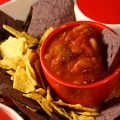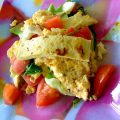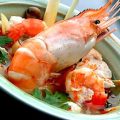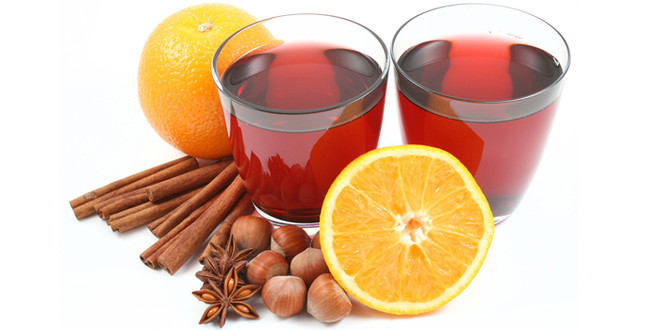 Making mulled wine - GermanGluhende wein - flaming wine, is just a modern designation for a drink with a rich history, the roots of which go back to the times when the ancient Romans began to mix wine with spices to better preserve it and give it a "noble" taste. In a 2000-year-old cookbook written by the Roman citizen Aliccius, you can find descriptions of making a drink from wine with the addition of cinnamon, cloves, thyme, coriander and bay leaf. At that time, spices were very expensive, and only a few residents of Rome could afford such wine. In cookbooks of the 16th century, recipes for making mulled wine based on Bordeaux and claret begin to appear. Honey, cinnamon, cardamom and galingal grass are mentioned as the main ingredients. Over time, the basis of the mulled wine recipe crystallized and acquired the very framework in which the modern hot drink is now prepared. The basis of any mulled wine is dry red wine (preferably ordinary and inexpensive), water, sugar, nutmeg, cloves. Of course, the masters of making mulled wine, and often it includes: lemon, orange or their zest, dried fruits, cinnamon, star anise, pepper, anise, honey, apple pieces and various fruit juices. The main charm of making mulled wine is that if you follow just a few rules, you can endlessly experiment with additives, wine varieties and methods of its preparation. This drink encourages the most unexpected ideas, the main thing is that you feel the properties of the components and imagine them in the future drink. Mulled wine is very easy to prepare, but does not tolerate haste or inattention. Just 10-15 minutes and the drink is ready. So, first of all, you will need wine. Its amount determines the number of people or personal needs. Don't try to do too much: if 1-2 glasses will do good - warm you up and lift your spirits, then 3-4 can already bring fatigue and a morning headache. The simplest table wine is best. If you are bored with its usual taste, try adding a little brandy, cognac or rum. Water is also important, but there should be a little of it - about a glass for every liter of wine.
Making mulled wine - GermanGluhende wein - flaming wine, is just a modern designation for a drink with a rich history, the roots of which go back to the times when the ancient Romans began to mix wine with spices to better preserve it and give it a "noble" taste. In a 2000-year-old cookbook written by the Roman citizen Aliccius, you can find descriptions of making a drink from wine with the addition of cinnamon, cloves, thyme, coriander and bay leaf. At that time, spices were very expensive, and only a few residents of Rome could afford such wine. In cookbooks of the 16th century, recipes for making mulled wine based on Bordeaux and claret begin to appear. Honey, cinnamon, cardamom and galingal grass are mentioned as the main ingredients. Over time, the basis of the mulled wine recipe crystallized and acquired the very framework in which the modern hot drink is now prepared. The basis of any mulled wine is dry red wine (preferably ordinary and inexpensive), water, sugar, nutmeg, cloves. Of course, the masters of making mulled wine, and often it includes: lemon, orange or their zest, dried fruits, cinnamon, star anise, pepper, anise, honey, apple pieces and various fruit juices. The main charm of making mulled wine is that if you follow just a few rules, you can endlessly experiment with additives, wine varieties and methods of its preparation. This drink encourages the most unexpected ideas, the main thing is that you feel the properties of the components and imagine them in the future drink. Mulled wine is very easy to prepare, but does not tolerate haste or inattention. Just 10-15 minutes and the drink is ready. So, first of all, you will need wine. Its amount determines the number of people or personal needs. Don't try to do too much: if 1-2 glasses will do good - warm you up and lift your spirits, then 3-4 can already bring fatigue and a morning headache. The simplest table wine is best. If you are bored with its usual taste, try adding a little brandy, cognac or rum. Water is also important, but there should be a little of it - about a glass for every liter of wine.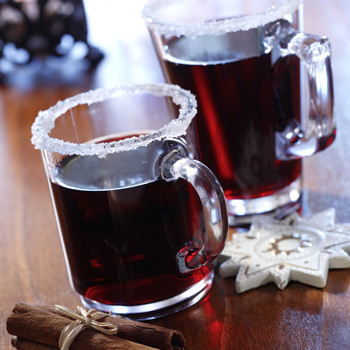 Mulled wine with spices
Mulled wine with spices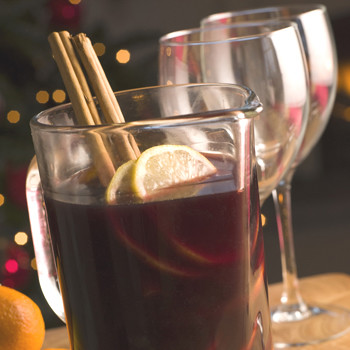 Mulled Wine with Fruit * Recipe available by clicking onThe name of the dish. Strands in each specific case are selected individually, but there is a generally accepted set, without which no mulled wine can do. These are sugar, cloves and cinnamon. In addition to them, cardamom, anise, honey, red and black peppercorns, nutmeg, slices of dried orange, lemon or apple can be added to mulled wine (in general, you can add a variety of dried fruits). Some of these components are interchangeable, for example, cardamom can be replaced by a citrus part, because cardamom has a lemon-eucalyptus flavor. Ginger, giving the sharpness and tartness of the drink, you can replace the peppers (in small quantities). Allowed to add to the drink pieces of fresh fruit and citrus. If the wine is dry, add sugar or honey. The latter is best mixed into the drink at the very end of cooking. Spices in mulled wine perform the role of supplementing the aroma of wine substances, so it is important not to clog the wine aroma, but to add, create a whole composition. The most important element of the preparation of mulled wine is the heating temperature, or rather, the temperature mode of preparation. The basic principle is to never allow the beverage to boil and even just warm up above the required temperature. The optimum temperature for mulled wine is 70 ° C, perhaps a little more. Do not overreach mulled wine, do not bring it to “pre-boiling”, it is better to underexpose a little. The main procedure: 1. A clove and nutmeg are poured into a Turk, some water is poured (glass or less) and cooked for about a minute. Then the decoction is infused for about 10 minutes. 2. In a refractory glass or ceramic dish (avoid metal), wine is poured in and put on fire. In the already heated wine pours the contents of the Turks, but without sediment. Everything is mixed, sugar is added and mixed again. 3. Then you can add the remaining components and then bring to a low temperature to the desired temperature (70 ° C) and pour it hot in cups or glasses.
Mulled Wine with Fruit * Recipe available by clicking onThe name of the dish. Strands in each specific case are selected individually, but there is a generally accepted set, without which no mulled wine can do. These are sugar, cloves and cinnamon. In addition to them, cardamom, anise, honey, red and black peppercorns, nutmeg, slices of dried orange, lemon or apple can be added to mulled wine (in general, you can add a variety of dried fruits). Some of these components are interchangeable, for example, cardamom can be replaced by a citrus part, because cardamom has a lemon-eucalyptus flavor. Ginger, giving the sharpness and tartness of the drink, you can replace the peppers (in small quantities). Allowed to add to the drink pieces of fresh fruit and citrus. If the wine is dry, add sugar or honey. The latter is best mixed into the drink at the very end of cooking. Spices in mulled wine perform the role of supplementing the aroma of wine substances, so it is important not to clog the wine aroma, but to add, create a whole composition. The most important element of the preparation of mulled wine is the heating temperature, or rather, the temperature mode of preparation. The basic principle is to never allow the beverage to boil and even just warm up above the required temperature. The optimum temperature for mulled wine is 70 ° C, perhaps a little more. Do not overreach mulled wine, do not bring it to “pre-boiling”, it is better to underexpose a little. The main procedure: 1. A clove and nutmeg are poured into a Turk, some water is poured (glass or less) and cooked for about a minute. Then the decoction is infused for about 10 minutes. 2. In a refractory glass or ceramic dish (avoid metal), wine is poured in and put on fire. In the already heated wine pours the contents of the Turks, but without sediment. Everything is mixed, sugar is added and mixed again. 3. Then you can add the remaining components and then bring to a low temperature to the desired temperature (70 ° C) and pour it hot in cups or glasses.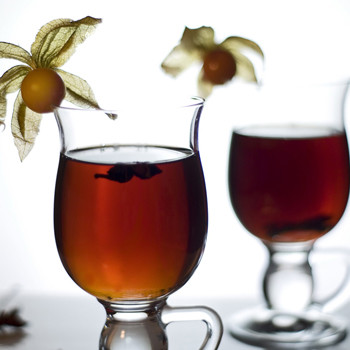
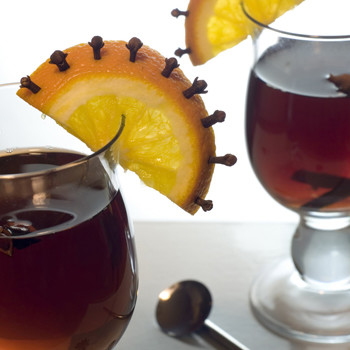 You can achieve a more intense taste of the drinkin several ways: either very slowly to heat over low heat, or to heat quickly enough and let it brew, while not allowing to cool, or make a more saturated syrup from spices, cooking and insisting it in the Turk a little longer. If you prefer fast heating and infusion, keep in mind that the white part in citrus slices gives bitterness during prolonged infusion; therefore, it is wiser to use only the zest in this case. and flavor. Do not reheat mulled wine again - unfortunately, all the magic of a fresh drink disappears completely after secondary heating. It is best to serve mulled wine in tall and narrow glass cups or glasses, but it can also be poured into ceramic cups, as was done in the old days. As an appetizer, you can serve dry biscuits, a piece of charlotte or other cake, fruit. In Holland, it is customary to serve puffs or donuts to the strong drink, in Germany - cakes. In general, snacks give the same freedom to improvise as the drink itself.
You can achieve a more intense taste of the drinkin several ways: either very slowly to heat over low heat, or to heat quickly enough and let it brew, while not allowing to cool, or make a more saturated syrup from spices, cooking and insisting it in the Turk a little longer. If you prefer fast heating and infusion, keep in mind that the white part in citrus slices gives bitterness during prolonged infusion; therefore, it is wiser to use only the zest in this case. and flavor. Do not reheat mulled wine again - unfortunately, all the magic of a fresh drink disappears completely after secondary heating. It is best to serve mulled wine in tall and narrow glass cups or glasses, but it can also be poured into ceramic cups, as was done in the old days. As an appetizer, you can serve dry biscuits, a piece of charlotte or other cake, fruit. In Holland, it is customary to serve puffs or donuts to the strong drink, in Germany - cakes. In general, snacks give the same freedom to improvise as the drink itself.

Making Money with Desserts: Success Stories
Evgeniya Polischuk (Fedutinova) instagram:@evgeniyafedutinovavk.com/janeshomebaking– It all started with baking for family and friends. Gradually, I started posting photos of my baked goods on Instagram – and orders started coming in. I made my first custom-made cake on October 13, 2014, and a little earlier I started making macaroons and cupcakes. You could say that the business “found me”, I am very […]

Soups are cold recipes with photos
Cold cucumber soup with yogurt and lemonsorbet from the chef of the restaurant La Taverna Alexander Zhurkin Photo: Getty Images Ingredients: Plain yoghurt – 125 g Cucumber – 150 g Lemon/lime sorbet – 50 g Cocktail shrimp – 24 g Fresh ginger juice – 1 g Lime juice – 5 g Fresh orange juice – 5 g Parsley – 1 g Pink pepper – 1 g Watercress – […]

barbeque kebab
Pork tenderloin in glaze Photo:Dmitry Bayrak/dbstudioPreparation time: 20 minutes + marinating time.Calories: 454 kcal per serving.For 4 servings: 4 pork tenderloins (approximately 300 g each), 1 onion, 2 cloves of garlic, 1 tsp. lemon zest, 1 tsp. lemon juice, a pinch of ground cumin, coriander and turmeric, 1 tbsp. vegetable […]

Pierre Duacan: dietary recipes: Ducane diet
Beetroot soup Photo:Season’S, Luxury Hotels RepresentationYou will need:· Boiled beetroot – 60 g· Fresh cucumbers – 20 g· Red radish – 20 g· Green onions – 10 g· Egg – 1 pc.· Drinking mineral water – 200 g· Salt – 1 gPreparation:· Boil the egg and beetroot.· Grate the cucumbers, radish and part of the beetroot. Put everything […]
